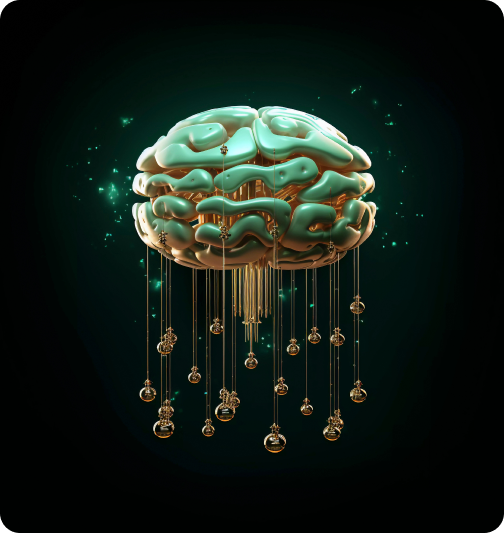Generative AI and UGC – A Match Made in Marketing Heaven?

The image accompanying this article was created by artificial intelligence upon request: GenerativeAI and UGC – A Match Made in Marketing Heaven?
Marketing is changing at a breakneck pace. Tasks that were unthinkable even a few years ago – like crafting blogs in a matter of minutes – are becoming increasingly common thanks to the disruptive power of generative AI tools. Think ChatGPT. Fed with the right “prompts” machines are now generating a wide variety of content, be it text (headlines, social post copies, blogs), images (text-to-images), or videos for marketing teams in very little time and with very little resources. While teams reap the benefits of these advanced technologies, there is another very important area they are shifting their focus to – user-generated content (UGC), which is steadily gaining ground as a more trusted source of information for customers compared to traditional ads posted by brands. Potential customers are scouring the internet for reviews from past users who have used the product or service. Photos, testimonials, videos, etc., shared by these customers are deemed more authentic and therefore valued compared to branded advertising. On cue, consumer brands are themselves turning to content creators, influencers, youtubers, and copywriters to create meaningful and relevant content that can actually improve conversions.
So how is the advent of and easy access to generative AI tools affecting UGC? Will we see brands changing their budget allocation, redirecting funds meant for content creators to investments towards Gen AI? Will Gen AI eliminate the need for UGC, or will we see a balancing act where brands make human creators enhance their content with the use of gen AI tools? To find out, let’s understand in detail what these terms mean and how one impacts the other.
What is Generative AI?
Generative AI is a certain category of AI where a simple prompt (a set of instructions in text) can help to generate content automatically in a matter of minutes. This could be any kind of a digital asset – a paragraph, a picture, a video, and even music. In marketing, where brands constantly need to create content to stay on top of customers’ minds and deepen their engagement levels, gen AI significantly lowers the time and skill level required to generate content, helping teams produce significantly more output with minimal resources. By generating content in near real time, it helps feed the content supply chain and levels the playing fields for brands that want to scale production but don’t have the means to do so. Some popular gen AI tools currently being used are ChatGPT (creates content in many styles and formats), Wordsmith (generates reports and summaries), Articoolo (creates articles in minutes), Zyro AI Writer (helps e-commerce specifically by generating product descriptions, and other copy based on keywords to improve SEO), and Synthesia (AI video generator).
Gen AI not just produces content via machine learning algorithms, NLP, and computer vision to analyze and synthesize content, it also helps to optimize content for specific users by analyzing customer behavior, their interests, and purchase habits, enabling teams to customize content to an unthinkable degree. These qualities make it an invaluable writing-intensive tool for marketing teams, which use it to:
- Write social post copies, blogs, product descriptions, emails, reports
- Create headlines, images, and videos
- Produce content in multiple languages
- Develop new campaigns based on input
- Generate product concept images
- Analyze online comments, videos, etc. to identify areas for new product innovationn
- Respond to customer feedback
- Ensure SEO-friendly and grammatically correct copy
And all of the above at record speed.
Gen AI benefits brands in a number of ways:
- By speeding up production time and boosting volumes
- Freeing up resources so they can invest time in more value-added activities
- Scaling up in a cost-effective way
- Producing content in record time
- Saving on costs by reducing manpower needs

What is User-Generated Content?
User-generated content (UGC) is created by influencers, customers, a brand’s followers, and even employees who create a variety of content to review a product or service. UGC can be of different types – from reviews, social posts, testimonials, images, comments, and podcasts to engaging videos. The rapidly evolving UGC landscape has become very important for marketers as customers turn away from branded posts to more relatable, authentic, and organic user-generated posts. As per the Nielsen Consumer Trust Index, 93 percent marketers now feel that UGC performs better than branded content as users feel its unbiased. It’s common now to see brands try to fill their social media pages with positive customer reviews, embed UGC in their website product pages, within their emails, and their targeted advertising campaigns.
Brands often ask followers and creators to create content that amplifies the brand’s voice. They share broad guidelines with copywriters, designers, YouTubers, and influencers while allowing room for creativity. They encourage customers to post reviews, images, testimonials, etc. and share this UGC on their own websites and social platforms. Well-made UGC creates more engagement and conversions compared to traditional picture-perfect ads.
UGC can also help a brand’s SEO prospects. Content creators can add backlinks to a brand’s website in their posts, boosting its search engine results by creating and sharing their content. This also helps increase traffic to a brand’s website, increasing chances of conversions and sales. Tapping into the huge potential of UGC has become more critical for brands that want to stand out in an environment where machine-generated content is everywhere.
So how will brands balance their need for generative AI with their need for UGC? How will gen AI impact UGC? Well, while these two forces may seem to be complete opposites, they can in fact work in tandem to help brands produce content that really resonates with audiences. Let’s look at the ways Gen AI is expected to impact UGC.
How Does Generative AI Impact UGC?
Can Make UGC Better
While UGC is a potent tool for brands, not all UGC is created equal. Many can be of poor quality and can in fact harm a brand. This is where Gen AI can step in and improve things. Brands can use Gen AI to improve the quality of existing UGC on a company’s website and adjusting it in various ways – improving the lighting and display, providing additional datapoints, making it more SEO-friendly, and ensuring it is consistent with a brand’s voice. It can also filter out or moderate content that goes against a brand’s principles or legal requirements.
Can Search for and Moderate Content
With the deluge of UGC flooding a market, it’s really difficult for brands to manually go through each and every piece and pick the most valuable ones. This is where Gen AI can help – it automatically sifts through massive volumes of data available on social platforms and identifies a variety of UGC, be it text, images, or videos that align with the brand’s values and goals. It By showcasing the right content (for example, a product testimonial highlighting its benefits) to the right audience, it helps to create a positive image of the product. Identifying which content can boost engagement is one of major benefits of AI.
Provide Inputs for Content Ideas
Gen AI can identify trending keywords and topics for a particular industry. Creators can then develop content on these topics by combining AI-generated text with UGC. Not just that, when people leave feedback and suggestions on UGC posts, Gen AI algorithms can analyze them and improve their own performance over time.
Can Help Content Creators Increase Output
Gen AI can help content creators to produce huge volumes of UGC very quickly by automating many aspects of the UGC life cycle. Creators can share prompts to create a basic structure for blogs, social media posts, images and videos, and then add their own perspective to them to create uniqueness. This ensures content is generated in a very short period of time and ensures a steady flow of content. Gen AI can also create entire videos with digital influencers showcasing a product, significantly reducing time and resources need to generate the content had it been entirely done by humans.
Can Help to Personalize the Content
Gen AI can help creators develop content that is more personalized for each user – like personalized emails or marketing messages. It can create messages that are aligned with the receivers’ interests, behaviours, and preferences, purchase history, and location.

Integrating generative AI with UGC is no doubt transformative, but there are some inherent pitfalls of relying on machine-generated data once should be mindful of, such as:
First, the tool is only as good as the data set that was used to train it. If the data is inaccurate, the content generated will be incorrect too. It may contain inaccuracies, inherent biases, etc.
Second, how well the tool performs depends on the quality of the prompt. If the prompt is too general and not detailed enough, the content will be of a low quality and it will be difficult for a brand to stand out. The tool cannot ideate from scratch and proper prompts need to be shared.
Third, being machine-generated, this kind of content will never win laurels for authenticity.
Fourth, marketers will stop visiting communities, forums, etc. – often a breeding ground for new ideas – as they will simply ask the Gen AI platform for information. Over time, the open exchange of ideas will reduce.
Finally, there is the very real problem of using Gen AI tools to create fake UGC, e.g., fake reviews. Gen AI can be misused to create false information that can misguide customers and even harm a brand. Also, there may be other ethical issues involving copyright concerns and misrepresentations.
Closing Thoughts
As technology blurs lines between human-and machine-generated content, brands will need to balance UGC and Gen AI judiciously for the best outcomes. The one thing that is clear is that no matter what the technology, human creativity and support will continue to be the bedrock of exceptional CX. Gen AI and UGC will not replace human skill anytime soon. What they will do though is work in tandem with humans to create unparalleled content experiences.




![[photo]](https://edna.io/wp-content/themes/edna/images/authors/rajrupa-ghoshal.jpg)
![[icon]](https://edna.io/wp-content/themes/edna/images/authors/ico-linkedin.svg)